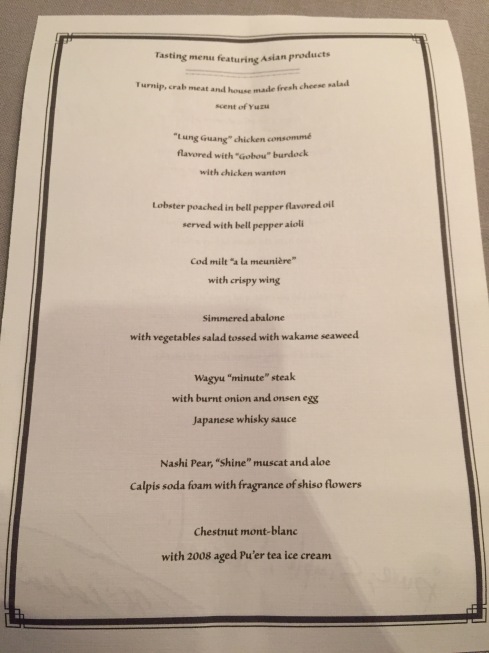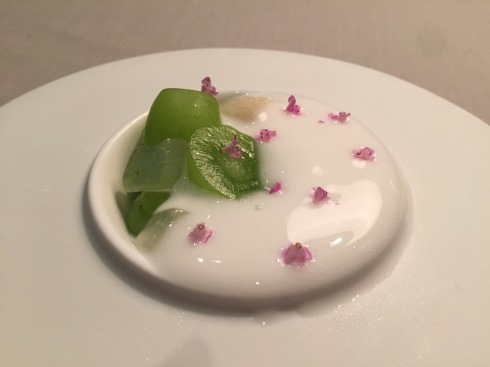Rating: 16/20
I chose Ta Vie (“your life”) for a treat after a week at the cudgels. Hong Kong doesn’t lack for dining options, but the unique ones are few. Bo Innovation aside, most of the top end Michelin restaurants are either rehashes of foreign concepts (Tenku Ryugin, L’Atelier Robuchon, Sushi Shikon) or Cantonese. Cantonese doesn’t lend itself well to solo dining, so I decided to go with a place with Ryugin (a restaurant I enjoy) pedigree. Chef Hideaki Sato of Ta Vie was previously head chef of 2* Tenku Ryugin, perched imperiously on the 101st floor of ICC Tower. He left the restaurant earlier this year to set up Ta Vie in May. Between Ryugin and Ta Vie, I decided on Ta Vie because I’m a sucker for the idea that a chef-proprietor puts a more personal touch to his menu.
Japanese-French is an intriguing and distinct brand of French cooking. The flavors are precise and restrained, something that can be “grasped by the tongue”, but never provokes uncomfortable sensations. Every style is defined by absence and presence. , Japanese-French’s absence is the absence of discomfort. You will not find tongue-numbing spiciness, nor will the portions overwhelm the digestion to generate uncomfortable tummy sensations, nor will be there be much bitterness. The overall tenor is “restraint”. What will be present in Japanese-French are intensified flavors – from its Franco-phile heritage the brigade of intense sauces – consommé, reductions etc, from its Japanese heritage a partiality to seafood like abalone and uni; what will also be present is the Japanese focus on pleasing textures (usually pliant/soft/buttery/watery rather than crisp) – think the explosion of cod milt (shirako) or buttery wagyu.
Value for money? At about US$300, Ta Vie is in the top bracket for pricing. I don’t think it is quite worth the money for the amount of fireworks, because Chef Sato’s dishes tend to play it fairly safe. A notable exception was an exciting cold composition of Calpis soda foam with grapes, pears and aloe. Ta Vie is the kind of restaurant that’s torn between two imperatives, destination dining and canteen for the moneyed. A lot of the dishes were elegant (e.g. the turnip salad, the simmered abalone), but far from mindblowing. But that makes it poor value for the destination diner, and I don’t think its well-established as a “regulars’” restaurant. I think it’s caught between two stools and hasn’t found its niche – the dining room was half-full on a Friday night, so maybe the market agrees with me.
Turnip, crab meat, and house made fresh cheese salad, scent of yuzu
- (3.5/5) A refreshing, if slightly pedestrian start.
“Lung Guang” chicken consommé flavored with “gobou” burdock with chicken wanton
- (4.5/5) A well prepared chicken consommé, with delicate dumpling. Excellent taste and concentrated flavor
Lobster poached in bell pepper flavored oil served with bell pepper aioli
- (4/5) Chinese lobster, good dish. Lobster was sinewy and well cooked.

Cod milt “a la meuniere” with crispy wing
- (3.75/5) Cauliflower paste, shirako pan-fried with tuile. Tasty

Simmered abalone with vegetable salad tossed with wakame seaweed
- (3.75/5) Abalone from Nagasaki, sudachi. The theme was understatement.
Wagyu “minute” steak with burnt onion and onsen egg, Japanese whisky sauce
- (4.25/5) Kuroge A4 wagyu, sliced, to maximize the fatty feel of beef. Tasty whisky sauce. A successful wagyu dish is aligned with the restauranteur’s interest, in that less is more. Full-on wagyu steaks lack the flavor and are too fatty to be truly delicious. Slicing wagyu (as here) is a sustained pleasure, the smoothness on the tongue, vs cubing wagyu (as at Brooklyn Fare) which increases the visceral pleasure of a burst of fat.
- As a main, this was a let-down. I believe a great dish should be more than a slapdash of ingredients (egg, beef, whisky). While it was well-prepared, it was ultimately a bit disappointing that a medley was the best the chef could come up with for a French meal.
Homemade pasta, Hokkaido uni, nori
- (3.75-4/5) Unusually soft pasta (texture of hor fun) with a nice helping of nori. Pleasant.
Nashi Pear, “Shine” muscat and aloe, Calpis soda foam with fragrance of shiso flower
- (4.75/5) The revelatory dish of the night. Calpis soda foam, sour, paired perfectly with cubes of pear, perfectly sweet muscat grapes and aloe. It broke the tacit agreement with the diner – “thou shall not use processed ingredients” – to great effect
Chestnut mont-blanc with 2008 aged Pu’er tea ice cream
- (3.75/5) Nice meringues and sweet chestnut puree. The Pu’er tea ice cream didn’t taste much of Pu’er, probably the cold disguised its flavor. (we need to add more sugar to cold drinks to get the same level of perceived sweetness)

































